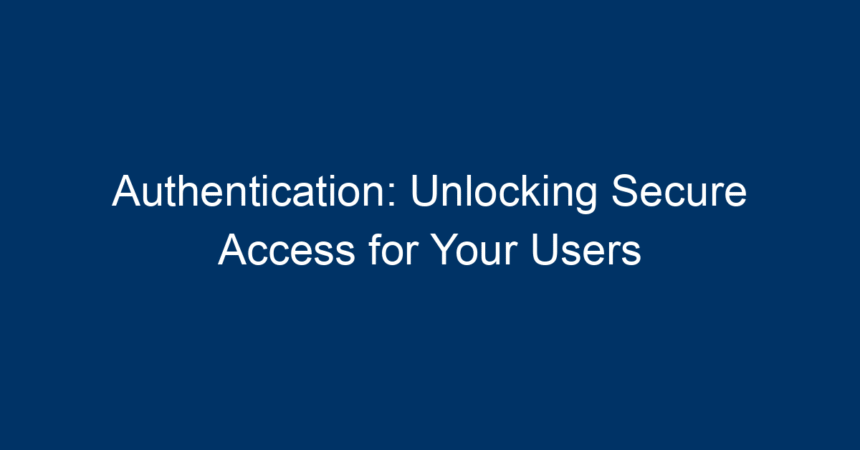In today’s digital landscape, where data breaches and cyber threats are prevalent, ensuring secure access to user accounts is more critical than ever. At the heart of this security lies authentication—the process that verifies users’ identities before granting access to sensitive information. In this comprehensive guide, we’ll explore various authentication methods, best practices, and emerging trends, empowering businesses and users alike to enhance security and streamline access.
What is Authentication?
Authentication is the process of verifying the identity of a user or system before granting access to confidential resources. It serves as the first line of defense against unauthorized access and data breaches, ensuring that only legitimate users can access sensitive information or functionalities.
Authentication can take various forms, typically categorized into:
- Something You Know: Passwords and PINs fall under this category.
- Something You Have: This includes physical devices like smart cards or mobile phones that generate time-sensitive codes.
- Something You Are: Biometric data such as fingerprints or facial recognition is increasingly popular for secure authentication.
Understanding these categories allows organizations to design robust authentication mechanisms tailored to their specific needs.
Why is Authentication Important?
1. Protects Sensitive Information
Every organization has data that needs to be protected—from personal user information to trade secrets. Effective authentication measures safeguard this sensitive information. By establishing a secure verification process, companies can significantly reduce the risk of data breaches.
2. Enhances User Trust
When users feel confident that their data is secure, they’re more likely to engage with a platform. Strong authentication mechanisms encourage user trust, which can lead to higher engagement rates, user retention, and overall satisfaction.
3. Regulatory Compliance
Many industries are subject to regulations concerning data protection (e.g., GDPR, HIPAA). Implementing robust authentication processes helps organizations stay compliant and avoid costly fines.
Types of Authentication Methods
1. Password-Based Authentication
The most common form of authentication is password-based. Users create a username and password combination to access their accounts. While familiar and straightforward, this method has drawbacks, mainly due to the complexity in password management and vulnerability to attacks.
Best Practices:
- Encourage users to create strong, complex passwords.
- Implement password expiration policies.
- Offer users guidelines on secure password storage.
2. Multi-Factor Authentication (MFA)
MFA adds an additional layer of security by requiring users to provide two or more verification factors. This could be a combination of something they know (password) and something they have (a smartphone app generating a one-time code).
Benefits:
- Mitigates the risk of unauthorized access, even if passwords are compromised.
- Provides users with different options for verification, enhancing user experience.
3. Single Sign-On (SSO)
With SSO, users can access multiple applications with one set of credentials. This not only enhances user convenience but also minimizes the number of passwords that users need to remember.
Advantages:
- Reduces password fatigue.
- Streamlines user authentication across multiple platforms.
4. Biometric Authentication
Biometric authentication uses unique physical characteristics like fingerprints, facial recognition, or voice patterns for user verification. This method is gaining traction due to its inherent security.
Considerations:
- Biometric data is sensitive and should be protected.
- Ensure compliance with privacy regulations when handling biometric information.
Emerging Trends in Authentication
1. Passwordless Authentication
As cybersecurity risks evolve, many organizations are exploring passwordless authentication methods. This approach eliminates the need for traditional passwords by introducing innovative alternatives like magic links or time-sensitive codes sent via email or SMS.
2. Behavioral Biometrics
Behavioral biometrics analyze patterns in user behavior, such as typing speed or mouse movement, to authenticate users. This method monitors user interactions and flags anomalies that may indicate unauthorized access attempts.
3. Decentralized Identity
Decentralized identity solutions empower users to manage their credentials without relying on centralized authorities. This paradigm shift promises improved security, privacy, and user control over personal data.
Implementing Authentication Strategies
1. Assess Your Needs
Before implementing an authentication strategy, evaluate your organization’s unique needs and the sensitivity of the data you handle. Consider the following:
- What type of data requires protection?
- Who are your users, and what authentication methods will they find convenient?
2. Choose the Right Tools
Select authentication tools that fit your organization’s structure and user base. Solutions may range from built-in authentication features in applications to third-party authentication providers.
3. User Education and Training
Educate users on the importance of secure authentication practices. Offer training sessions on creating strong passwords, recognizing phishing attempts, and understanding the need for two-factor authentication.
4. Continuous Monitoring and Updating
Authentication processes should never be static. Regularly assess your authentication methods against emerging threats and adapt to changes in user behavior or technological advancements.
Conclusions: Actionable Insights for Secure Access
Effective authentication is essential for securing not just data, but also user trust and business integrity. To ensure robust authentication systems:
-
Embrace Multi-Factor Authentication: This significantly reduces the risk of unauthorized access, adding layers of security.
-
Stay Informed: Keep up with the latest trends and technologies in authentication to implement cutting-edge solutions.
-
Educate Users: An informed user base is a critical component of any security strategy. Ensure your users understand the significance of authentication.
- Regularly Review Security Policies: Adapt and evolve your authentication practices in line with emerging threats and regulatory changes.
By prioritizing authentication, businesses not only safeguard their assets and user information but also pave the way to a sustainable and secure digital ecosystem. Stay vigilant, adapt quickly, and prioritize user security to build trust and engagement in a world where security is paramount.




